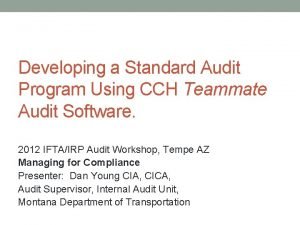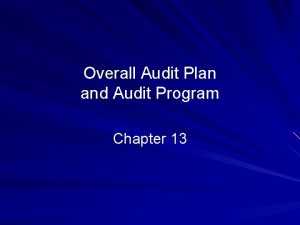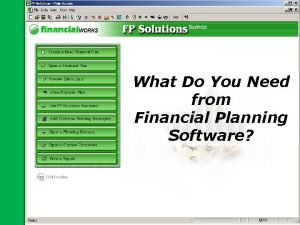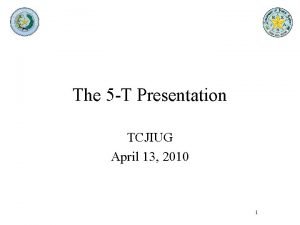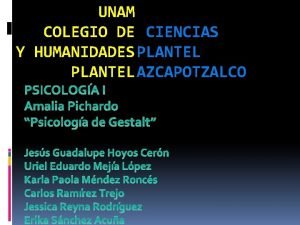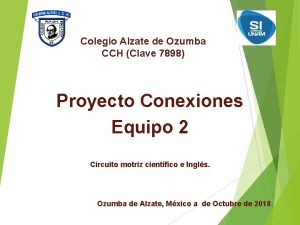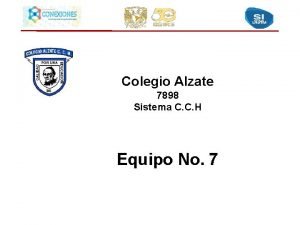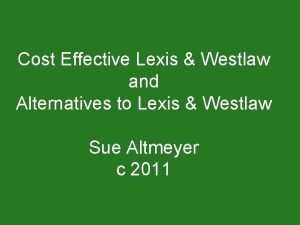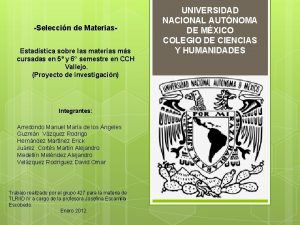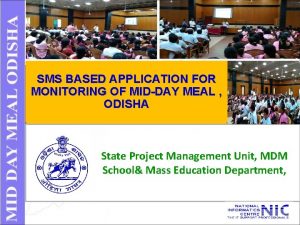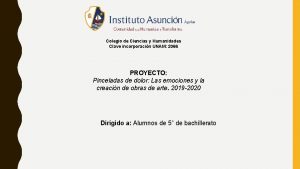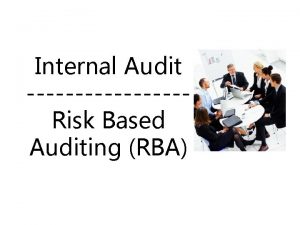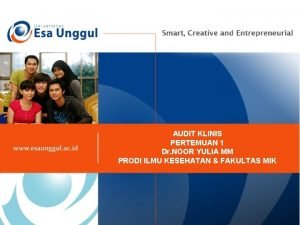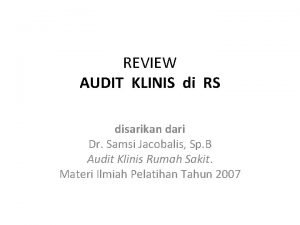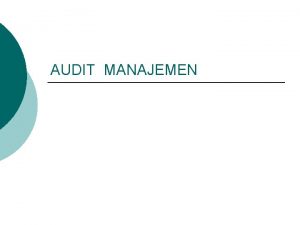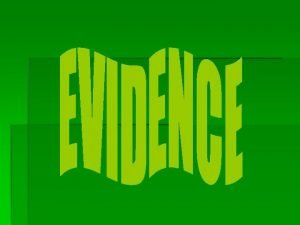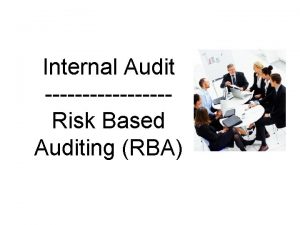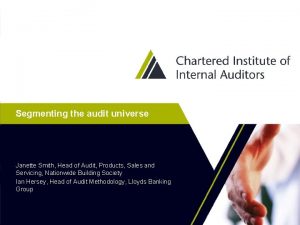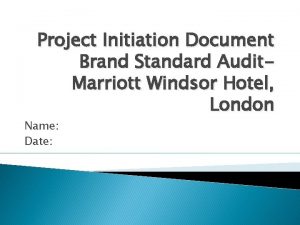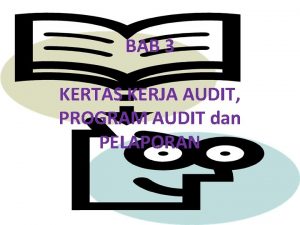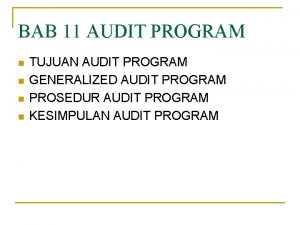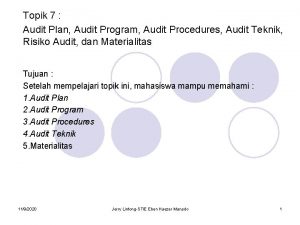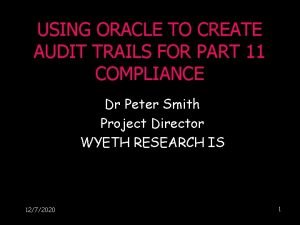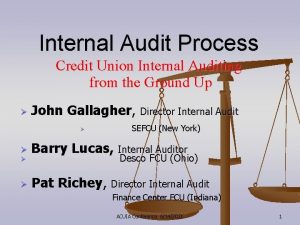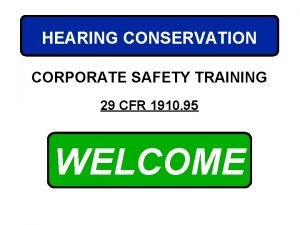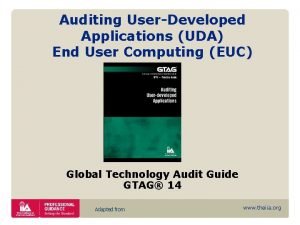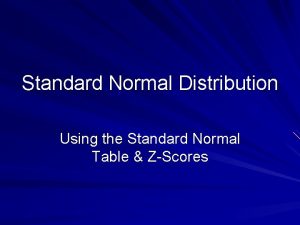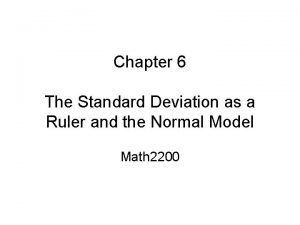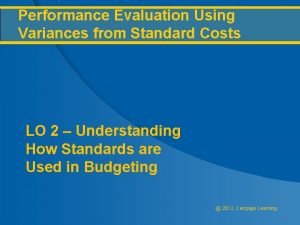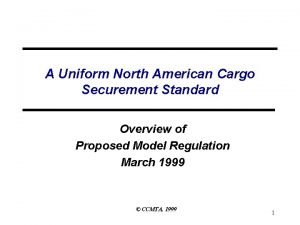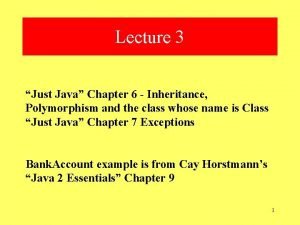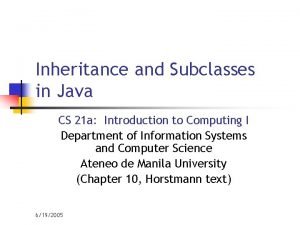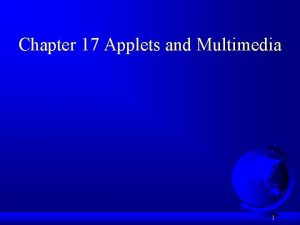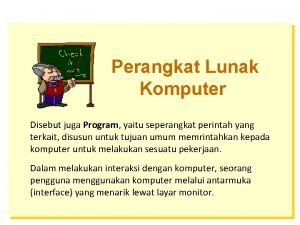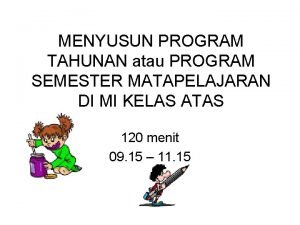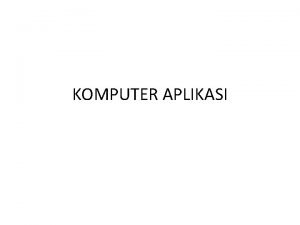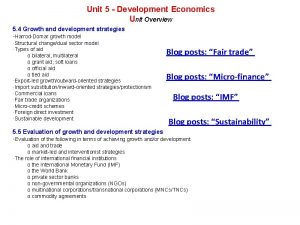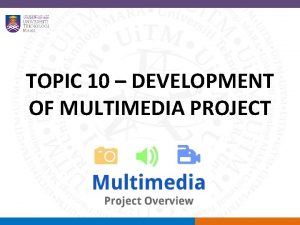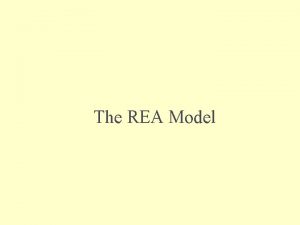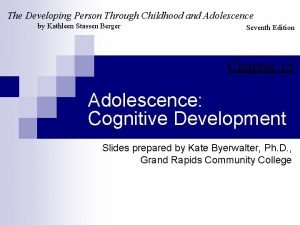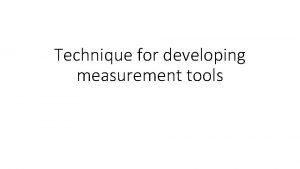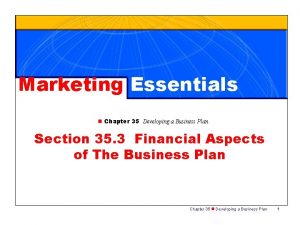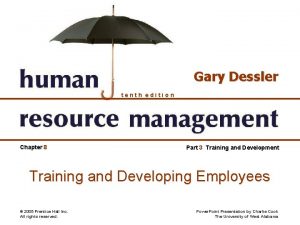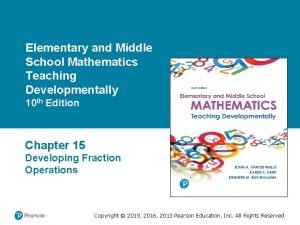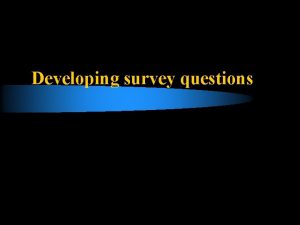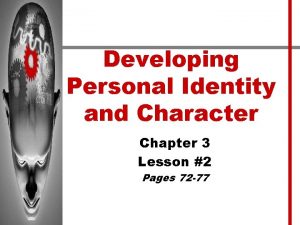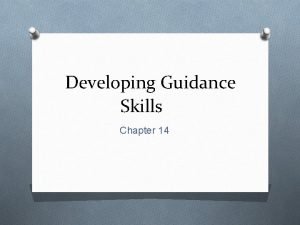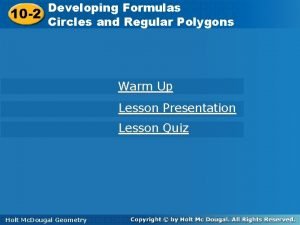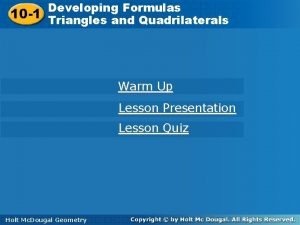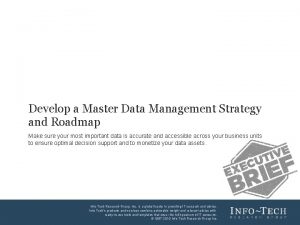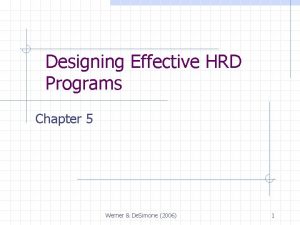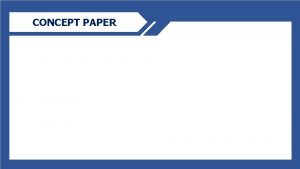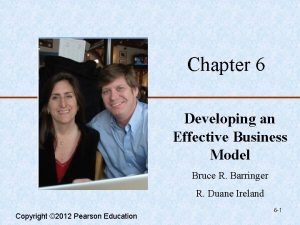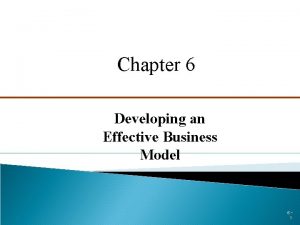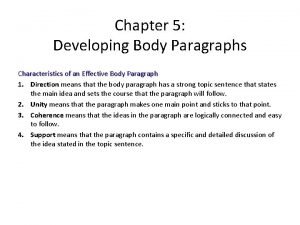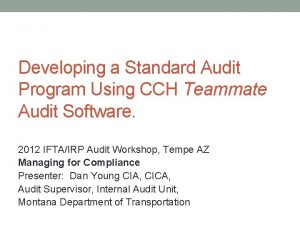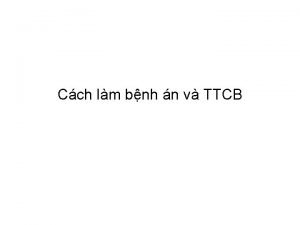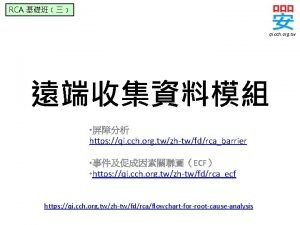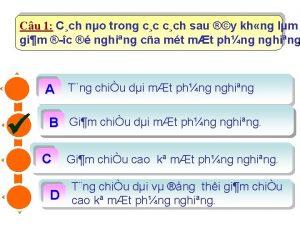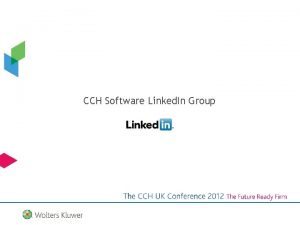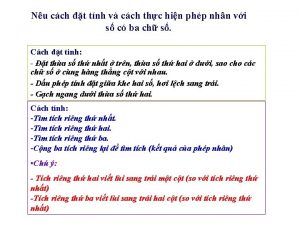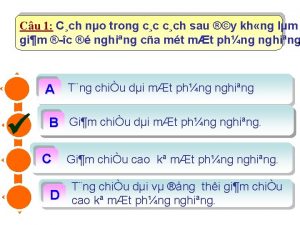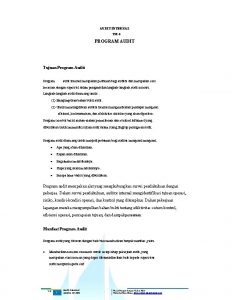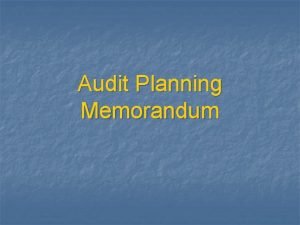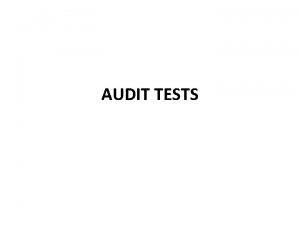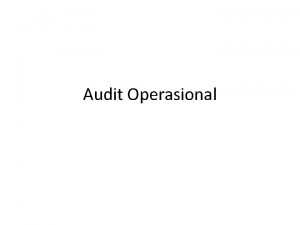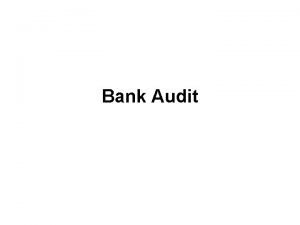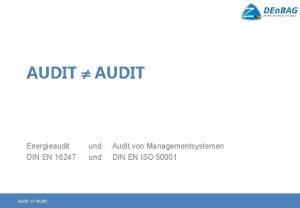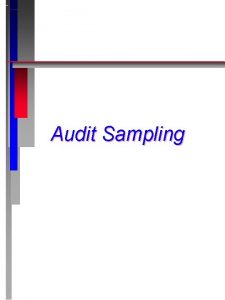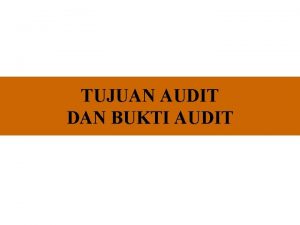Developing a Standard Audit Program Using CCH Teammate



























































































- Slides: 91

Developing a Standard Audit Program Using CCH Teammate Audit Software. 2012 IFTA/IRP Audit Workshop, Tempe AZ Managing for Compliance Presenter: Dan Young CIA, CICA, Audit Supervisor, Internal Audit Unit, Montana Department of Transportation

2 Each jurisdiction should use an audit program. An audit program provides for consistent application of audit procedures, serves as a training tool for new auditors, and facilitates the review of the audit. An audit program does not preclude the use of auditor judgment. Deviations from an audit program are acceptable if they are reasonable given the audit circumstances and must be documented in the audit file and approved by the audit supervisor

3 Tax & Fee Audit Program The Audit Program has been developed to address each phase of the audit process: 1. Planning • Preliminary Work • Audit Planning 2. Fieldwork 3. Report • Report Process • Report Finalization

4 Preliminary Work Program This program is comprised of audit procedure steps which can be performed prior to assigning the audit project to the auditor responsible for completing the audit engagement.

5 Preliminary Work Program Audit Procedure - Compile Background Information • Attach background reports from ACS-TS, ACS-RS, Fuel Refund Voucher Report, Secretary of State, SAFER and prior audits as needed to document the background information. (3 hours)

6 Preliminary Work Program Audit Procedure - Compile Background Information Additional Guidance: Pull only information that is useful in the audit. These are typical items but all items are always necessary. General • Secretary of State Info • SAFER Web Snapshots • Prior audits IFTA • Account Core Data - Alternative Name & Addresses - Account Tax Type Data - Credential Inquiry & Detail - Tax Return Summary Journal - Tax return Summary - Detailed Fuel Use Tax Return

7 Preliminary Work Program Audit Procedure - Compile Background Information Additional Guidance: IRP - Carrier Information - Carrier Fleet Information - Supplemental History - Carrier Mileage Report - Carrier Vehicle Listing Note: If the IRP Registration Years under review are different from the IFTA audit period. Print the "Detail Fuel Use Tax Return" screens for the applicable quarters.

8 Preliminary Work Program Audit Procedure - Compile Background Information Additional Guidance: REFUND Cares Report identifying the payments made. SU Account Core Data - Alternative Name & Addresses - Account Tax Type Data - Tax Return Summary Journal - Tax Return Summary - Fuel Refund Summary Report DISTRIBUTOR - Account Core Data - Alternative Name & Addresses - Account Tax Type Data - Account Balances Bond Balances - Oracle Motor Fuel System the Distributor Summary (latest amended return).

9 Preliminary Work Program Audit Procedure: Returns and Applications Pull original copies of the appropriate tax returns and applications. Scan hard copy tax returns and/or applications. (2 hours)

10 Preliminary Work Program Audit Procedure: Returns and Applications Additional Guidance: The tax returns/application should be scanned in as a one document.

11 Preliminary Work Program Audit Procedure: Returns and Applications Additional Guidance: The tax returns/application should be scanned in as a one document.

12 Preliminary Work Program Audit Procedure - Audit Period Determine the audit periods and the tax types to be audited for the taxpayer under audit. Determine the budget based on the program steps required to perform this audit. Remember to change the hours in each of the steps to reflect their final allocation. (2 hour) Provide the audit supervisor and audit manager (via email) the budget breakdown by phase.

13 Preliminary Work Program Audit Procedure - Audit Period Additional Guidance: When determining the audit period, make sure the application/license dates correspond to the audit period. There was an estimated budget developed for each procedure. In this step you identify how many vehicles the company has or refunds the company has which identifies the budget by step. This step then calculates the total budget for planning, fieldwork and report process. Estimate Budget requirement for the audit:

14 Preliminary Work Program Audit Procedure - Audit Period Purpose: MCA 15 -70 -355; Statute of limitations. Except in the case of a fraudulent return or of neglect or refusal to make a return, every deficiency must be assessed within 3 years from the due date of the return or the date of filing the return, whichever period expires later.

15 Preliminary Work Program Audit Procedure - Audit Notification For IFTA or IRP audits prepare either the 30 day audit notification letter, the Contact Authorization, vehicle listing/fleet verification and taxpayer information form or for Refund or SU audits prepare and send the audit notification letter and the taxpayer information form. . (1/2 hour)

16 Preliminary Work Program Audit Procedure - Audit Notification Additional Guidance: These letters are in Central Stores. For IFTA or IRP you will need the Vehicle Listing, 30 day notification letter, contract authorization and the taxpayer information. For refunds or SU you will need refund notification letter, contact authorization and the vehicle listing. The initial letter should include the period to be covered by the audit, taxpayer information form, contact authorization, and from requesting a list of the vehicles and/or equipment reported on the tax returns and applications. TAX RETURNS = IFTA, SPECIAL FUEL USER APPLICATIONS = IRP, REFUNDS (PTO, OFFROAD). Note: There are no vehicles or equipment associated with a Motor Fuel Distributor tax return or a Agricultural Tax Refund Application.

17 Preliminary Work Program Audit Procedure - Audit Notification Purpose: IFTA Audit Manual A 610 AUDIT NOTIFICATION At least 30 days prior to conducting a routine audit, the licensee should be contacted in writing and advised of the approximate date that an audit is to be conducted and the time period the audit will cover. The notification will provide the licensee the opportunity to make the required records available and provide assurance the tentative audit schedule is acceptable. . 100 For purposes of documentation and to avoid misunderstanding, a copy of the notification letter should be incorporated into the audit file detailing the tentative audit date and the documentation the licensee is required to furnish. . 200 For just cause, notification requirements may be waived. . 300 All pre-audit contact should be confirmed in writing.

18 Preliminary Work Program Audit Procedure - Audit Notification Purpose: IRP Audit Manual 601. Pre-Audit Contact (a) At least 30 days prior to conducting the Audit, the Registrant shall be contacted and advised that an Audit is to be conducted of Operational Records substantiating distance reported on the apportioned registration application(s). Through the initial or subsequent pre-audit contacts, the Registrant should be advised of the Registration Year(s) to be audited, the type of Operational Records to be audited, the person(s) conducting the Audit, and the proposed Audit commencement date. The pre-audit contacts will provide the Registrant the opportunity to make the required Operational Records available. (b) For documentation purposes and to avoid misunderstanding, any pre-audit correspondence and documentation of pre-audit contact shall be incorporated into the Audit file. (c) For just cause, notification requirements may be waived. It is suggested that the auditor obtain an agreement to waive notification requirements from the Registrant prior to conducting an Audit. The Audit may be postponed for just cause.

19 Preliminary Work Program Audit Procedure: Spreadsheets Complete the appropriate spreadsheets for each tax type from MDT systems (ACS, HOC reports, and the tax returns & applications): • IFTA (Low-2 hours, Med - 4 hours, High – 6 hours) • IRP (1 hour) • SU (4 hours) • Refunds (Off-Road, PTO, AG & Refer)(1/2 hour per refund type) • Distributor (3 hours)

20 Preliminary Work Program Audit Procedure: Spreadsheets Additional Guidance: While entering the information, make sure the spreadsheets balance to the system.

21 Preliminary Work Program Audit Procedure: Spreadsheets Purpose: IFTA Audit Manual *A 680 AUDIT FILE CONTENTS The audit file will contain, but not be limited to, the following: . 100 Schedules. 005 Summary schedules shall include reported and audited fuel and distance for each affected jurisdiction. They shall also include the assessment or refund for the jurisdictions and the net total assessment or refund due for the audit, including all penalties and interest. . 010 Supplementary schedules shall provide additional detail for results on the summary schedules. Supplementary schedules will contain, but not be limited to, schedules showing how audited fuel and distances were calculated and the computation of adjustment factors determined from a sample, if applicable.

22 Preliminary Work Program Audit Procedure - Balance Document the spreadsheets are balanced to the system and lock the system. (1/2 hour)

23 Preliminary Work Program Audit Procedure - Balance Additional Guidance: The Audit Tech will usually balance the spreadsheets prior to the assigning the audit. If we are unable to complete the balancing process, the Audit Tech will add a step in the planning section of the audit to request the final balance. Once it is balanced, lock this schedule to prevent future changes.

24 Preliminary Work Program Audit Procedure - Taxpayer Response Scan the completed documents : • Contact Authorization • Taxpayer Info • Vehicle Listing • Sample records (1 hour)

25 Audit Planning Program

26 Audit Planning Program Audit Procedure - Balance Spreadsheet Verify the tax returns, application and the MDT systems used to create the spreadsheet balance. Review the steps performed by the Audit Technician. (Spreadsheets & Balance) If there are differences or the spreadsheet(s) require additional data input, work with the Audit Technician to balance or complete the data entry. If errors are MDT input error and are noted on the balanced spreadsheet, establish an audit issue. (IFTA/IRP 1 hour, Multiple tax types 2 hours)

27 Audit Planning Program Audit Procedure - Balance Spreadsheet Additional Guidance: You should copy the IFTA spreadsheet, all the IRP spreadsheets and all the refund spreadsheets from preplanning and bring it forward to this step for use during the audit. The original should remain untouched in the preplanning section.

28 Audit Planning Program Audit Procedure - Balance Spreadsheet Purpose: IFTA Audit Manual • *A 680 AUDIT FILE CONTENTS • The audit file will contain, but not be limited to, the following: • . 100 Schedules • . 005 Summary schedules • Summary schedules shall include reported and audited fuel and distance for each affected jurisdiction. They shall also include the assessment or refund for the jurisdictions and the net total assessment or refund due for the audit, including all penalties and interest. • . 010 Supplementary schedules • Supplementary schedules shall provide additional detail for results on the summary schedules. Supplementary schedules will contain, but not be limited to, schedules showing how audited fuel and distances were calculated and the computation of adjustment factors determined from a sample, if applicable.

29 Audit Planning Program Audit Procedure - Analysis For each tax type, perform an analytical review. You are looking for things that are odd or unusual. Document your analysis and develop questions for the taxpayer interview. - IFTA (1 hour) - IRP (1 hour) - SU (1 hour) - Refrigerator (1 hour) - Off Road (1 hour) - Distributor (1 hour) - PTO (1 hour)

30 Audit Planning Program Audit Procedure - Analysis Additional Guidance: You are looking for things that are odd or unusual. Some examples are: • Changes from one return/application to the next; • Constant or extreme mpg; • large fluctuations in distance or fuel; • reported fluctuations in fuel types, numbers of amendments, changes in the size of operation; • number of jurisdictions traveled; • calculation errors; • seasonal fluctuations; and • tax paid fuel.

31 Audit Planning Program Audit Procedure - Analysis Purpose: IFTA Audit Manual *A 220 EXAMINATION STANDARDS. 100 Preaudit Analysis Preaudit analysis shall be conducted and documented. Documentation shall include, but is not limited to, an analysis of information reported on the IFTA returns for any unusual areas or trends that might need further examination IRP Audit Manual (c) It is suggested that the auditor conduct an analytical review of the Registrant’s application subject to Audit to become more familiar with the Registrant’s operations. As a part of the analytical review, the auditor should summarize application information; note unusual trends or variances draw conclusions, and include the analytical review documentation in the Audit file.

32 Audit Planning Program Audit Procedure -Sample Selection Based on the analysis performed, select sample time periods for each audit type. (2 hour)

33 Audit Planning Program Audit Procedure -Sample Selection Additional Guidance: For IFTA/IRP you need to select 3 quarters that would cover the most jurisdictional miles and tax types. Make sure 2 of the quarters are back to test proper cutoff. The IFTA IRP Sample spreadsheet in Team. Stores is useful for helping to identify the quarters and document your analysis. For SU you need to select 3 quarters that would provide a good representation. Make sure 2 of the quarters are back to test proper cutoff. For refunds, we will select 20% or a minimum of three of the total applications/returns filed. You will need to justify any sample sizes that do not conform to the above selections. Consult the Audit Supervisor for guidance as necessary.

34 Audit Planning Program Audit Procedure -Sample Selection Purpose: IFTA Audit Manual A 530 SAMPLING Unless a specific situation dictates, all audits will be conducted on a sampling basis. . 100 Sample period(s) must be representative of the licensee's operations. . 200 Sample period(s) may be different for member jurisdictions due to seasonal operations. . 300 The licensee should be allowed input into sample selection if legitimate reasons exist. . 400 An agreement that the sampling methodology is appropriate should be signed by the licensee and the auditor.

35 Audit Planning Program Audit Procedure -Sample Selection Purpose: IRP Audit Manual 703. Sampling and Extrapolation Procedures • (a) After completing the review of internal controls, the auditor should discuss proposed sample periods and Operational Records with the Registrant. Source documents/IVDR’s and distance summaries for no less than three representative months of the Reporting Period for the Registration Year being audited will be selected for Audit with respect to Jurisdictional distance and other attributes required by Article IV of the APM. After the auditor reconciles the distance summary (ies), differences should be summarized and included as a part of the Audit file. Generally, Audits are to be conducted on a sampling basis. However, a complete Audit of the Registrant’s distance records for the twelve-month period or actual months of operation may be necessary if tests of internal controls reveal major weaknesses in the Registrant’s reporting system, or if there is an absence of distance summaries. • (b) Auditor judgment is required in determining the nature of errors encountered. Depending on the nature of the errors, they may be treated as isolated errors (and included in findings without being projected) or they may be projected. Sampling and extrapolation procedures performed by the auditor should be documented in the Audit file.

36 Audit Planning Program Audit Procedure -Sample Selection Purpose: IRP Audit Manual 703. Sampling and Extrapolation Procedures (c) Documentation such as source documents/IVDR’s and distance summaries odometer and hubodometer readings, and other Operational Records used by a Registrant to substantiate Total Distance traveled, must be considered by an auditor in determining the acceptability of the Registrant’s reporting system. In the event an auditor is unable to determine any reasonable method to assign a portion of the unreported distance traveled by a Registrant, such distance traveled shall be assigned to Member Jurisdictions on the basis of each Member Jurisdiction’s audited Jurisdiction Distance. Allocation of such distance traveled must not be done in such a way as to unjustifiably increase the In-Jurisdiction Distance percentage of the Base Jurisdiction conducting the Audit. (d) Before making projections to the Registrant’s distance per summary or application, the suitability of the use of the distance per summaries or application for projection purposes shall be ascertained. It is generally preferable to project to summary distance (corrected as necessary) than to application distance. Differences between the distance per summary and distance per application should be investigated to determine their cause. Also, the auditor shall make a determination as to whether the distance per summary or application includes only the operations of Apportionable Vehicles during the Reporting Period (Section 701(b)). The auditor shall document in the Audit file the conclusions made as to whether the distance per summary or application has sufficient accuracy and reliability to be used in sampling projections.

37 Audit Planning Program Audit Procedure -Entrance Conference Prepare entrance conference questions. Use existing questionnaires as a guide and include questions from the analytical review. (2 hours + 1 hour for each additional tax type)

38 Audit Planning Program Audit Procedure -Entrance Conference Prep. Additional Guidance: Pull appropriate questionnaires from Team. Stores. These questionnaires are guidance only and should be merged or changed based on the analytical work. DO NOT GIVE THESE TO THE TAXPAYER TO COMPLETE. Available questionnaires are: • AG • Distributor • Motor Fuels • Off Road • Refer • Retail

39 Audit Planning Program Audit Procedure -Entrance Conference Prep. Purpose: IRP Audit Manual 701. Initial Audit Procedures • (a) It is suggested that the auditor determine if the Registrant was previously audited. If a previous Audit was conducted, any findings of non-compliance should be documented in the Audit file. • (b) The auditor should review the Registrant’s registration files to identify the population of Vehicles in the Registration Year and in the Reporting Period that pertain to the Fleet subject to Audit. The auditor should then either • (i) list the Vehicles to be audited, indicating equipment number, unit weight, make of Vehicle, Vehicle identification number and inclusive months each Vehicle was in the Fleet; or • (ii) Document an alternative method of identifying the Vehicles (and the time periods they were registered). • The auditor should use the Vehicle listings, or alternative method documented, to select Vehicles for Audit with respect to sampling distance records. The Vehicle listings or alternative method of identifying the Vehicles shall be included as a work paper in the Audit file.

40 Audit Planning Program Audit Procedure -Opening Conference Contact the taxpayer and do the following: • Identify yourself as the auditor that will be performing the examination • Answer any initial questions • Explain the audit process • Ask the taxpayer to explain the processes and procedures used to record and compile the information reported for each tax type. • Document the Internal Controls. Ensure you obtain sample records to document the process flow. • Discuss whether the audit will be conducted on-site. • Discuss the sample selection and verify that the sample is representative of the company’s operations. • Schedule a time and date to conduct the audit. (2 hours – add ½ hour for each additional tax type)

41 Audit Planning Program Audit Procedure -Opening Conference Additional Guidance: In order to structure your interview with the taxpayer you should have reviewed the questionnaire template and based on your analysis developed any additional discussion points or issues needing clarification. Note: We intend to perform most audits on site. If the taxpayer does not have a business office, you may arrange a suitable location to conduct the fieldwork: Discuss with audit supervisor if you are not sure.

42 Audit Planning Program Audit Procedure -Opening Conference Purpose: IFTA Audit Manual A 630 OPENING CONFERENCE • . 100 Except as defined in A 630. 200, a documented opening conference shall held with the licensee outlining the licensee's operation, audit procedures, records to be examined, sample period, sampling procedures, etc. The method by which said conference takes place is subject to the base jurisdiction’s discretion and may include, but is not limited to, the following: in person meetings, telephone discussions, written correspondence, facsimile transmission, and electronic mail messaging. The licensee and auditor should determine who has the responsibility for the final acceptance of audit findings and who should be involved in the closing conference. • . 200 In those circumstances where an opening conference is not held and/or completed in accordance with A 630. 100 because the audit is being performed in accordance with IFTA Articles of Agreement R 1210, documentation must be provided as to why the opening conference was not held and/or completed. • . 300 Open communication between the licensee and auditor is desirable. IRP Audit Manual 602. Initial Audit Conference A documented initial Audit conference should be held with the Registrant to discuss the Registrant’s operations and record keeping system, Audit procedures, Operational Records to be examined, sample period, sampling procedures, etc. Open communication between the auditor and Registrant is desirable.

43 Audit Planning Program Audit Procedure -Background Information Compile the background section for the audit report and document it in the profile. (1 hour)

44 Audit Planning Program Audit Procedure -Background Information Additional Guidance: Select the Profile tab for the project: Select the "Background" Tab: Enter the information to be included in the Background section of the report. (Note: This is exactly how the report will look, remember to have the amount of detail required for your audit activity. ) • Describe the type of business • Number of vehicles • Number of jurisdictions effected • Date of original license When you are entering text in the specific areas of the profile related to the report this is the text which will be brought into the 360 report.

45 Audit Planning Program Audit Procedure -Internal Control Assessment Based on the Internal Controls documented during the opening conference. Determine the adequacy of Internal Controls as described. (1 hr. )

46 Audit Planning Program Audit Procedure -Internal Control Assessment Additional Guidance: By studying and evaluating the internal control procedures, the auditor identifies apparent weaknesses in the internal control system. To assist in evaluating the system of internal control the auditor should consider the following: • Types of errors and irregularities that could occur. • Control procedures to prevent or detect such errors and irregularities. • Whether the procedures have been adopted and are being followed satisfactorily. • Weaknesses which would enable errors and irregularities to pass through existing control procedures. • The effect these weaknesses have on the nature, timing, and extent of auditing procedures to be applied.

47 Audit Planning Program Audit Procedure -Internal Control Assessment Purpose: IFTA Audit Manual A 640 EVALUATION OF INTERNAL CONTROL The auditor's study and evaluation of the licensee's internal accounting control system has several identifiable phases. . 100 Review and Documentation • The review of the system is an information-gathering phase in which the auditor, through inquiry and observation, determines the licensee's accounting policies and procedures. The auditor's objective is to obtain an understanding of the flow of transaction processing. As part of this process, the auditor will: . 005 Find out if there have been changes in the licensee's accounting procedures or operations during the audit period; . 010 Identify the records that the licensee keeps to support the tax return; . 015 Audit the support documentation and check with the licensee to determine if any pre-auditing of support documentation is done prior to data entry; and The auditor documents the understanding of the licensee's system of internal control in the work papers by completing a questionnaire designed for this purpose or by diagramming or describing the flow of transactions in flowchart or narrative form. To clarify this understanding, the auditor may select a few transactions of each transaction type and trace them through the accounting system from initiation to ultimate recording. . 200 Preliminary Evaluation By studying and evaluating the internal control procedures, the auditor identifies apparent weaknesses in the internal control system.

48 Audit Planning Program Audit Procedure -Internal Control Assessment Purpose: IFTA Audit Manual A 640 EVALUATION OF INTERNAL CONTROL (Cont’d. ) . 300 Tests of Compliance If controls are inadequate to permit reliance, the auditor may make a more extensive review and perform tests of compliance. If weaknesses identified in the preliminary evaluation preclude reliance, or if the auditor believes that more efficient or effective audit tests are possible without reliance, the auditor will plan audit procedures without any further study and evaluation of accounting control. . 400 Report on Weaknesses The extensiveness of the review of the system and whether tests of compliance are made are matters of the auditor's judgment. Any serious weaknesses identified will be formally reported promptly to the licensee rather than at completion of the audit.

49 Audit Planning Program Audit Procedure -Internal Control Assessment Purpose: • IRP Audit Manual • 702. Evaluation of Internal Control • (a) The auditor’s study and evaluation of the Registrant’s internal accounting control system has three identifiable phases: • (i) review and documentation; • (ii) tests of compliance; and • (iii) report on weaknesses. • (b) Review and documentation includes the following steps: • (i) determine if there have been changes in the Registrant’s accounting procedures or operations during the Audit period; • (ii) identify the Operational Records that the Registrant maintains to support the registration application; and • (iii) review the supporting documentation and determine if any review of the supporting documentation is performed by the Registrant prior to data entry. • The auditor should document his/her understanding of the Registrant’s distance accounting system by completing an internal control questionnaire designed for this purpose or by diagramming or describing the flow of transactions in flowchart or narrative form. It is suggested that a sample copy of the Registrant’s reports, trip records or other documents examined by the auditor be included in the Audit file.

50 Audit Planning Program Audit Procedure -Internal Control Assessment Purpose: IRP Audit Manual 702. Evaluation of Internal Control (Cont’d. ) (c) To clarify understanding gained from performing these steps, the auditor may select a few transactions of each transaction type and trace them through the accounting system from initiation to ultimate recording. (d) By studying the internal control procedures, the auditor can identify potential weaknesses in the internal accounting control system. (e) Tests of compliance are performed to determine the effectiveness of the internal controls. Based on the result of the compliance tests, the auditor makes an assessment of the degree of reliance that can be placed on the internal controls. If reliance on the internal controls is high, then the substantive tests to be performed may be reduced. Conversely, if reliance on the internal controls is low, then the substantive tests to be performed may be increased. (f) The nature of the review of the system and whether tests of compliance are made are matters of the auditor’s judgment. (g) Weaknesses identified in the Registrant’s internal control system shall be reported to the Registrant and documented in the Audit file.

51 Audit Planning Program Audit Procedure -Sample Notification Confirm your sample selection based on the interview. Prepare a sample agreement form to be signed by the taxpayer. Note: You will need to prepare a sample audit notification if you will be mailing this to the taxpayer. (1/2 hour)

52 Audit Planning Program Audit Procedure -Sample Notification Additional Guidance: If this is not a desk audit, the auditor should prepare the form and have the audit client sign the form when the auditor goes on site. If it is a desk audit, complete the send the agreement along with the Sample Notification Letter and the records release form. Forms you may need in Team. Stores are: • Records Release (if desk audit) • Sample Agreement • Sample Audit Notification (if desk audit)

53 Audit Planning Program Audit Procedure -Desk Audit If this will be a desk audit, provide the audit technician with the sample form that includes the information for records; sample notification, sample agreement and a records release. (1/2 hour) Note: We intend to perform most audits on site. If the taxpayer does not have a business office, you may arrange a suitable location to conduct the fieldwork: Discuss with audit supervisor if you are not sure.

54 Audit Planning Program Audit Procedure -Desk Audit Additional Guidance: You will need to consider several factors when deciding whether to perform the audit on site or in the office: • What are the average miles traveled? • What is the size of the fleet? • Does the taxpayer have a business location other than their home? • Where is the business located? • How many jurisdictions are effected? • Use common sense. If this is a small one truck operation, e. g. farm or ranch, requiring hours of travel to reach the taxpayer is it really cost effective to do an on-site audit? If in doubt, discuss the options with the audit supervisor.

55 Audit Planning Program Audit Procedure -Statute of Limitations Based on your audit planning and the scheduling of field work determine whether we will run into a Statute of Limitation problem with any of the IFTA quarters, IRP years, or Refund Applications. If there is, request the audit supervisor to download the SOL adjustment steps. (1 hr. )

56 Audit Planning Program Audit Procedure -Statute of Limitations Purpose: • MCA 15 -70 -355; Statute of limitations. Except in the case of a fraudulent return or of neglect or refusal to make a return, every deficiency must be assessed within 3 years from the due date of the return or the date of filing the return, whichever period expires later.

57 Audit Planning Program Audit Procedure -Finalize Audit Scope and Budget Contact the Audit Supervisor. Discuss whether the scope and objectives established are adequate, discuss the status of the audit, determine if we need to pull additional steps (like steps to create the summaries), when you plan on going on site and any audit concerns you may have. Finalize the scope of the audit and the objectives of the audit and document them in the profile. (2 hrs. ) Note: This is the point you should review your budget and discuss any issues that you see that will prevent you from delivering the project within budget and within the established schedule.

58 Audit Planning Program Audit Procedure -Finalize Audit Scope and Budget Additional Guidance: Select the "Audit Scope and Methodology" Tab: Enter the information to be included in the Audit Scope and Methodology section of the report. (Note: This is exactly how the report will look, remember to have the amount of detail required for your audit activity. ) The text you are entering in the specific areas of the profile related to the report is the text which will be brought into the 360 report.

59 Audit Planning Program Audit Procedure -Finalize Audit Scope and Budget Purpose: IFTA Audit Manual *A 230 REPORTING STANDARD The report shall contain a clear statement of the scope of the audit and must also clearly state and describe the results of the auditor's examination.

60 Audit Planning Program

61 Audit Planning Program Audit Procedure -Contact Information Complete the contact information form in planning and administration section. Only MDT employees should be on the contacts tab. Non-MDT employees should be added to the contact sheet in the administration section. (1 hour)

62 Audit Planning Program Audit Procedure -Contact Information Additional Guidance: If there are no MDT staff, please insert the Ghost employee on the contacts tab.

63 Fieldwork Phase Within the Fieldwork Audit Phase we developed specific Fieldwork Audit Programs for each audit type performed and for specific elements we deemed necessary to preform IFTA and IRP audit procedures. For each of the Audit Programs, we have developed audit procedures that allow the auditor to review and test the records provided by the audit client. After performing the audit procedures the auditor should have sufficient and reliable evidence to support any opinions or conclusions about the clients records and the accuracy and completeness of the distance and fuel information reported on the returns and registrations.

64 Fieldwork Program: General Fieldwork Audit Procedure - Review Data • Review the information provided by the taxpayer to determine if all requested information was submitted for review. (If not, contact the taxpayer to obtain missing records or determine why records were not provided. ) (1/2 hour)

65 Fieldwork Program: General Fieldwork Audit Procedure - Review Data Additional Guidance: Be sure the taxpayer has provided or has made available all of the information necessary for you to perform an audit of all tax types under review. Consider what information you will need to evaluate the tax returns and/or applications. Communicate with the taxpayer: If you need additional information, make sure the taxpayer understands exactly what is needed and why. We cannot have an audit delayed because records are not being provided. If there will be a significant delay, make sure you communicate this to the audit supervisor.

66 Fieldwork Program: IFTA/IRP Testing

67 Fieldwork Program: IFTA/IRP Testing Audit Procedure - Sample Agreement Review the sample agreement with the taxpayer, verify the taxpayer agrees with the sample agreement and obtain the taxpayers signature. Scan in the signed document. (1 hr. )

68 Fieldwork Program: IFTA/IRP Testing Audit Procedure - Mathematical Correctness Check the mathematical accuracy of the tax return for each sample return. (1 hr. )

69 Fieldwork Program: IFTA/IRP Testing Audit Procedure - Mathematical Correctness Additional Guidance: The best way to do this is to pull in the tax return and use tick marks to demonstrate what you tested.

70 Fieldwork Program: IFTA/IRP Testing Audit Procedure - Quarterly Recaps For each sample quarter, tie the tax return to the quarterly recap. Ensure the fuel and mileage is properly reported on the tax return. Document differences. (1 hr. )

71 Fieldwork Program: IFTA/IRP Testing Audit Procedure - Quarterly Recaps Additional Guidance: If the taxpayer does not keep quarterly recaps, request the audit supervisor to pull the new steps for your audit and put NA on all of these procedure steps.

72 Fieldwork Program: IFTA/IRP Testing Audit Procedure - Monthly Summaries For the sample quarters tie the quarterly recaps to the information on the monthly summaries. Document differences. Determine whether the monthly recap is the best form to use for your further testing. If it isn’t, consult the audit supervisor and revise steps accordingly. (3 1/2 hours)

73 Fieldwork Program: IFTA/IRP Testing Audit Procedure - IF/IR Sample Units Based on the table below, determine how many sample units you will use for testing. Fleet Size Sample Size 1, 000 + units 30 1, 000 units 25 500 units 20 100 units 15 50 units 8 10 units 3 Select the units that would give you the best coverage of miles. Note: For the single quarter, you do not need to select the same units as the other 2 quarters. (1 1/2 hrs. )

74 Fieldwork Program: IFTA/IRP Testing Audit Procedure -Jurisdictional Testing Determine if jurisdictional distance and fuel is reasonably allocated. (2 hrs. )

75 Fieldwork Program: IFTA/IRP Testing Audit Procedure -Jurisdictional Testing Additional Guidance: If odometers readings are recorded at jurisdictional lines recalculate jurisdictional distance from odometers for sample units to determine if jurisdictional distances are accurately recorded on the trip report. If not, judgmentally select trips from sample units and test for reasonableness of the jurisdictional mileage using distance software. Does the taxpayer report non-taxable miles? If yes, determine if miles qualify under ARMS 18. 103 & 104 and recalculate off road miles and tie back to the tax return.

76 Fieldwork Program: IFTA/IRP Testing Audit Procedure -Spreadsheet Adjustments Summarize the issues noted, complete the records evaluation form and finalize audit issues. (2 hrs. ) Enter audit adjustments in the spreadsheet(s) for each tax type and reconcile them to make sure all items are accounted for properly. Complete the comment section at the bottom of the spreadsheet for each adjustment. (1 hr. per spreadsheet) (Note: if multiple entries are made, you should save each one along the way to document your process. )

77 Fieldwork Program: IFTA/IRP Testing Audit Procedure -Spreadsheet Adjustments Additional Guidance: Discuss the issues with the Audit Supervisor before entering the information into the spreadsheet. This is when you should finalize the decision on whethere should be a penalty assessment for IFTA. To assist you in making the determinations, you can pull IFTA-IRP Records Evaluation

78 Fieldwork Program: IFTA/IRP Testing Audit Procedure -Conclusions Conclude on: • Whether the tax return(s) is (are) supported by the records. • Whether all IFTA taxes have been paid by the company. (1 hour)

79 Fieldwork Program: IFTA/IRP Testing Audit Procedure -Conclusions Additional Guidance: • Finalize audit issues and determine if we can combine any of the findings. (2 hours) • Discuss the issues with the Audit Supervisor before entering the information into the spreadsheet. This is when you should finalize the decision on whethere should be a penalty assessment for IFTA/IRP. (2 hours) • Copy the spreadsheet completed and balanced during the pre- planning step to use for each audit finding/or adjustment. These spreadsheets will be used to support your issue(s).

80 Fieldwork Program: IFTA/IRP Additional Steps

81 Fieldwork Program: IFTA/IRP Additional Steps Audit Procedure - Noncompliance Document the non-compliance. Discuss the alternate approach with the audit supervisor and revise the hours to complete the audit as appropriate. (1 hour)

82 Fieldwork Program: IFTA/IRP Additional Steps Audit Procedure - Mileage Calculation Using records with odometer readings and/or jurisdictional miles from trip sheets build the monthly mileage summaries. (2 hours + ¼ hour for each sample unit – round up to the nearest ½ hour)

83 Fieldwork Program: IFTA/IRP Additional Steps Audit Procedure - Fuel Calculation Using fuel invoices build the monthly fuel summaries. If you can’t determine the reasonableness of fuel, you will need to disallow the reported gallons. (2 hours + ¼ hour for each sample unit – round up to the nearest ½ hour)

84 Fieldwork Program: IFTA/IRP Additional Steps Audit Procedure - Tax Return Comparison Compare these summaries to the tax return and document the differences. Then complete the records evaluation form. (2 hours)

85 Fieldwork Program: IRP Analysis

86 Fieldwork Program: IRP Analysis Audit Procedure - IRP Findings Based on the exceptions identified through the detailed testing above, determine whether the IFTA quarterly summaries can be used to test IRP. If not, contact the Audit Supervisor to determine what additional steps should be taken. (1 hour)

87 Fieldwork Program: IRP Analysis Audit Procedure - IRP Testing Pull the IFTA Tax Return for the 4 quarters of IRP. Total these tax returns and compare the information to the IRP Schedule B and to the annual summary. Investigate any differences. (4 hours per fleet).

88 Fieldwork Program: IRP Analysis Audit Procedure - Spreadsheet Summarize the exceptions noted and finalize audit issues. Enter audit adjustments in the IRP spreadsheet(s) for each fleet and reconcile them to make sure all items are accounted for properly. (1 hour per fleet)

89 Fieldwork Program: IRP Analysis Audit Procedure - Spreadsheet Additional Guidance: Discuss the issues with the Audit Supervisor before entering the information into the spreadsheet. This is when you should finalize the decision on whethere should be a penalty assessment for IRP.

90 Fieldwork Program: IRP Analysis Audit Procedure - Conclusions Conclude on: • Whether the application(s) is (are) supported by the records. • Whether all Fees have been paid by the company. (1 hour) add. 5 hours for each additional fleet.

91 QUESTIONS ? ? ? ?
 Irptesting
Irptesting What is teammate audit software
What is teammate audit software Overall audit plan
Overall audit plan Fp solutions financial planning software
Fp solutions financial planning software Tcic less than full access test answers
Tcic less than full access test answers Triad cch color
Triad cch color Citační norma ččh
Citační norma ččh Citační norma ččh
Citační norma ččh Clave cch azcapotzalco
Clave cch azcapotzalco Colegio alzate cch ozumba
Colegio alzate cch ozumba Colegio alzate cch ozumba
Colegio alzate cch ozumba Cch intelliconnect cost
Cch intelliconnect cost Seleccion de materias cch sur
Seleccion de materias cch sur Cch studio
Cch studio Mdm daily sms format
Mdm daily sms format Cch sur clave
Cch sur clave Perbedaan audit konvensional dengan audit berbasis risiko
Perbedaan audit konvensional dengan audit berbasis risiko Perbedaan audit medis dan audit klinis
Perbedaan audit medis dan audit klinis Beda audit medis dan audit klinis
Beda audit medis dan audit klinis Penyelesaian audit dan tanggung jawab pasca audit
Penyelesaian audit dan tanggung jawab pasca audit Konsep dasar audit manajemen
Konsep dasar audit manajemen Prosedur audit bottom-up dan audit top-down
Prosedur audit bottom-up dan audit top-down Auditor definition
Auditor definition Perbedaan audit konvensional dengan audit berbasis risiko
Perbedaan audit konvensional dengan audit berbasis risiko Audit comes from the latin word
Audit comes from the latin word What is audit universe
What is audit universe Marriott brand standard audit
Marriott brand standard audit Program kerja audit manajemen
Program kerja audit manajemen Contoh audit program
Contoh audit program Disaster recovery audit program isaca
Disaster recovery audit program isaca Audit program yang baik harus mencantumkan
Audit program yang baik harus mencantumkan 21 cfr part 11 oracle
21 cfr part 11 oracle Acuia conference
Acuia conference Hearing conservation program audit checklist
Hearing conservation program audit checklist End user computing audit program
End user computing audit program Revenue cycle internal controls
Revenue cycle internal controls End user computing audit
End user computing audit Std error
Std error Power dynamics of standard language
Power dynamics of standard language Standard cost system
Standard cost system Bahagian pembangunan kurikulum pendidikan khas
Bahagian pembangunan kurikulum pendidikan khas Standard normal.table
Standard normal.table Using the standard deviation as a ruler
Using the standard deviation as a ruler Performance evaluation using variances from standard costs
Performance evaluation using variances from standard costs Adding and subtracting standard form
Adding and subtracting standard form Using system.collections
Using system.collections Accumulator ac
Accumulator ac Standard training program
Standard training program North america cargo securement
North america cargo securement Polynomial addition program in c using linked list
Polynomial addition program in c using linked list Polymorphism bank account example
Polymorphism bank account example Savings account java
Savings account java Moving ball program in java using applet
Moving ball program in java using applet Sequential program and an event-driven program?
Sequential program and an event-driven program? Perangkat lunak disebut juga
Perangkat lunak disebut juga Menyusun program tahunan dan program semester
Menyusun program tahunan dan program semester Microsoft excel merupakan program aplikasi .......
Microsoft excel merupakan program aplikasi ....... Aplikasi pengolah angka dari microsoft adalah ....
Aplikasi pengolah angka dari microsoft adalah .... Ms word
Ms word Pretest: developing an academic and career plan
Pretest: developing an academic and career plan Harrod domar model
Harrod domar model Comparative education in developing countries
Comparative education in developing countries Nationalist position definition
Nationalist position definition Various stages of multimedia project
Various stages of multimedia project Example of rea
Example of rea Carly is given grapes and strawberries
Carly is given grapes and strawberries The developing person through childhood and adolescence
The developing person through childhood and adolescence The developing person through childhood 7th edition
The developing person through childhood 7th edition The technique of developing and
The technique of developing and Sampling plan steps
Sampling plan steps Polar front latitude
Polar front latitude Difference between developing and underdeveloped countries
Difference between developing and underdeveloped countries Chapter 35 developing a business plan
Chapter 35 developing a business plan Chapter 8 training and developing employees
Chapter 8 training and developing employees Transnational crime and the developing world
Transnational crime and the developing world Chapter 15 developing fraction concepts
Chapter 15 developing fraction concepts Leadership philosophy
Leadership philosophy Developing survey questions
Developing survey questions Developing personal identity
Developing personal identity Lesson 2 developing personal identity and character
Lesson 2 developing personal identity and character Alternative hypothesis
Alternative hypothesis Developing guidance skills
Developing guidance skills Chapter 14 developing guidance skills
Chapter 14 developing guidance skills 9-1 developing formulas for triangles and quadrilaterals
9-1 developing formulas for triangles and quadrilaterals 10-2 developing formulas for circles and regular polygons
10-2 developing formulas for circles and regular polygons 10-1 developing formulas for triangles and quadrilaterals
10-1 developing formulas for triangles and quadrilaterals Master data management roadmap
Master data management roadmap Designing effective hrd programs
Designing effective hrd programs What is a concept paper
What is a concept paper Barringer business model
Barringer business model Core strategy business model
Core strategy business model Characteristics of body in essay
Characteristics of body in essay
